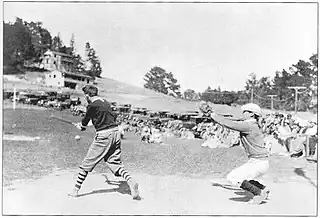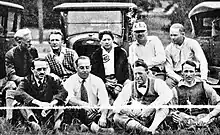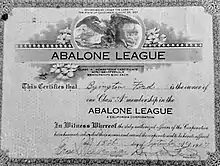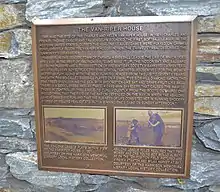Abalone League
The Abalone League was an amateur baseball and softball club based in Carmel-by-the-Sea, California from 1921 through 1938. It was the first softball league in the Western United States. The League was incorporated on September 8, 1927.[1] The League was a Carmel focal point for many years. Early players included writers Jimmy Hopper and Harry Leon Wilson, actor Frank Sheridan, developer of Pebble Beach S. F. B. Morse, Philip Wilson, Sr., of the Philip Wilson Building, and Fred and Harrison Godwin of the La Playa Hotel.[2]
 Abalone League team | |
| Sport | Baseball, softball |
|---|---|
| Founded | 1927 |
| Founder | Charles King Van Riper and Helen Van Riper Thorne Taylor Talbert Josselyn |
| Ceased | 1938 |
| Motto | You name the game, we'll win it! |
| No. of teams | Shamrocks, Tigers, Giants, Rangers |
| Countries | United States |
| Headquarters | Carmel-by-the-Sea, California, US |
History


The Abalone League had its beginning on Carmel Point adjacent to Carmel-by-the-Sea, California, after World War I in 1921.[3] Games were held in a rough diamond field next to the Charles King Van Riper house among the pine trees overlooking the sea. Charles and Helen van Riper and his friends, aviator Thorne Taylor and writer Talbert Josselyn (brother of photographer Lewis Josselyn) founded the first softball league in the Western United States, dubbed the Abalone League. The league got its name from the Abalone Cove, which was adjacent to the playing field. They played every evening in the summer months and on Sundays all year round. Six teams made up the league. Josselyn, Lee Gottfried, and Thorn Taylor were some of the first players. Charles Van Riper was the first "commissioner" and was responsible to begin each season. Journalist Robert Welles Ritchie served as the league's first umpire. They played two games on Sunday and had three playing fields, at Carmel Point, Carmel Woods, and the Hatton Fields.[4][5][3]

The “Abalone Song,” was penned in Carmel around 1907 by writer George Sterling, and his friends, Jack London, and Sinclair Lewis. They sang the song while pounding Monterey Bay abalone at gala Carmel beach parties.[6][7]
Oh, some drink rain
And some champagne,
And whiskey by the pony,
But I will try a dash of rye,
And a hunk of abalone.
Writer and journalist Frederick R. Bechdolt was an early member of the Abalone League, along Edward Kuster, Charley Van Riper, James Hopper, John Hillaiard, Ernest Schweninger, Talbert Josselyn, R. C. Smith, and Winsor Josselyn.[4]
Talbert Josselyn was known as the "Judge Landis" of the Abalone League. Winsor Josselyn, brother of Lewis and Talbert Josselyn, worte about the league's opening in the January 16, 1931, edition of the Carmel Pine Cone. Winsor said: "The four captains are in daily conference with their teams. The Pine Cone is preparing special sports extras to satisfy the game-mad fans. A poet is inditing an heroic verse, a composer is pounding out an anthem, and artist is creating a master banner to float above the park." The four teams in the League at the time were the Shamrocks, the Tigers, the Giants, and the Rangers. Carmel Mayor Herbert Heron pitched the first ball that ushered in the 1931 Series of twelve games.[8]
In 1925, the San Francisco Chronicle ran an essay entitled "Carmel Sports." The pictures showed members of the league. One picture showed artist Jo Mora at bat. Two Abalone Cup trophies were awarded at the end of each season with the losing team giving a gala banquet at the La Playa Hotel. One trophy was silver called the Hooper Cup, the other was an ornate stove top from the Monterey Herald stove, called the Herald trophy. Each year the winning team player's names were itched on each trophy and they were kept by the team until the next season.[4][5][9]
Each team had ten players, two women, and the rest men. Ages were between ten and fifteen on the same team as with forty and fifty-year-olds. The teams were made up of writers, artist, musicians, stars of the stage, and a grocery truck driver. Team names were Shamrocks, Sardines, Whales, Seals, Sanddabs, Goldfish, and the Sharks. Later the teams were uniforms.[4][10]

On September 8, 1927, the Abalone League became a corporation and was chartered under the laws of the State of California. The founders of the league and first board of directors were aviator and developer Byington Ford, businessman James Cooper Doud, Talbert Josselyn, director Frank Sheridan, and businessman Ernest Schweninger. The articles of incorporation stated that the "Abalone League is a cooperative association organized for the purpose of fostering athletics, particularly baseball, and to provide for the physical benefit of Carmel's citizenry." As a corporation, the league was able to sell certificates of membership[1] to help fund the league's events.[3]
The Abalone League disbanded in 1938 just before World War II.[4]
In 1940, Winsor Josselyn was interviewed by the Carmel Pine Cone and talked about how the Abalone League was a Carmel focal point for many years. Early group players included writers Jimmy Hopper Bob Pinkerton, and Harry Leon Wilson, actor Frank Sheridan, developer of Pebble Beach S. F. B. Morse, Kit Cooke, Helen Wilson, Elliot and Marion Boke, Philip Wilson, Sr., (of the Philip Wilson Building), Col. Fletcher Dutton, Fred and Harrison Godwin (of the La Playa Hotel), and Don Hale.[2] Carmel builder A. Carlyle Stoney built his home on Carmel Point, on the third base line of the Abalone League baseball field. He sponsored a team with three of his brothers that played in the league.[11]
Carmel Arts and Crafts Club
In April 1927, the Abalone League bought the deed to the Carmel Arts and Crafts Club and theater on Monte Verde Street[12][3] and the proceeds were used to pay off the Forest Theater debts.[13] At one point, the Abalone League renamed it the Abalone Theatre, and staged its own plays at the Arts and Crafts Theater, where the Golden Bough Playhouse now stands, to make money for the league.[14]
Byington Ford and his wife Ruth, were active in the Abalone League productions at the Arts and Crafts Theater. Original dramas by local playwrights as Martin Flavin, Perry Newberry, and Ira Remsen were produced in the Arts and Crafts Theater at that time.[15] The play The Bad Man, a three-act comedy by American playwright Porter Emerson Browne, was put on by the Arts and Crafts Theater on January 15, 1926. Artist Jo Mora, Byington Ford, and other Abalone Players were among the actors in the play.[16]
In 1929, the Abalone theater lost money and was sold it to Edward Kuster. Kuster remodeled the facility and renamed it the Studio Theatre of the Golden Bough. He moved all of his activities, plays concerts, traveling theatre groups, lectures, to the theatre on Monte Verde Street. In 1940, Kuster renamed the theater to the Golden Bough Playhouse and again put on plays, foreign films, and movies.[14][2][5][17]
Legacy

At the Van-Riper House in Carmel-by-the-Sea, there is a historic plaque about the Abalone League. The text of the plaque provides a history of the league. It says:
This was the site of the Charles and Helen van Riper house. In 1921, Charles and friends Thorne Taylor and Tal Josselyn founded the first softball league in the and Western United States, dubbed the Abalone League. Games were played on Carmel Point, directly below the Van-Riper house. In 1926. The Carmel Cymbal described the community obsession:
There is, in this seaside town of Carmel, a baseball league the like of which does not exist in the rest of America. Six teams make it up, the indoor bat and ball are used, the players are a cross-section of present-day society – bankers, carpenters, artists, delivery boys, truck drivers, school teachers, housewives (for the women and girls play along with the men) running in ages from twelve to seventy years and with this so-called baseball played on a diminutive side-hill diamond among the pine trees overlooking the sea, with broomstick-like bat and grape-fruit like ball. There is seriousness, and at times a cave-man savagery, that causes the hair of those in control of the league to curl violently from the roots outward. One would think that the fate of the nation depended on the way in which the abalone league games are run and that the business of life consisted not in running grocery stores or selling real estate, but in winning one’s game on Sunday afternoon.
Notable alumni
See also
References
- "Carmel Ball League Is Now Incorporated". The Californian. Salinas, California. 8 Sep 1927. p. 5. Retrieved 2022-07-15.
- "Abalone League Village Focal Point for Years". Carmel Pine Cone. Carmel-by-the-Sea, California. 19 Apr 1940. p. 7. Retrieved 2022-07-16.
- Frost, John W. (1987). Monterey Peninsula's Sporting Heritage. Arcadia Publishing. p. 15. ISBN 9780738555898. Retrieved 2022-07-16.
- Irene Gaasch (15 Apr 1976). "Abalone League, a glorious league in Carmel's golden age". Carmel Pine Cone. Carmel-by-the-Sea, California. pp. 1, 18. Retrieved 2022-07-16.
- Hudson, Monica (2006). Carmel-By-The-Sea. Carmel-by-the-Sea, California: Arcadia Publishing. pp. 115–116. ISBN 9780738531229. Retrieved 2022-07-16.
- Judith A. Eisner (September 24, 1970). "The fabulous career Byington Ford. Carmel Pine Cone". Carmel Pine Cone. Carmel-by-the-Sea, California. p. 8. Retrieved 2023-03-11.
- "The Abalone Song". Monterey Peninsula Toy Box. Carmel-by-the-Sea, California. Retrieved 2023-03-11.
- Winsor Josselyn (16 Jan 1931). "Abalone Series Opens". Carmel Pine Cone. Carmel-by-the-Sea, California. p. 1. Retrieved 2022-07-16.
- Bostick, Daisy F.; Castelhun, Dorothea (1925). Carmel--at Work and Play. pp. 43–44, 94. Retrieved 2022-07-14.
{{cite book}}:|work=ignored (help) - Ford, Tirey (1926). Dawn and the Dons; the Romance of Monterey. The Bruce Brouch Press. p. 209. ISBN 9781432516307. OL 11930655M. 1432516302. Retrieved 2022-07-16.
- "Carlyle Stoney". Carmel Pine Cone. Carmel-by-the-Sea, California. 19 August 1949. p. 12. Retrieved 2022-06-25.
- "real Estate Transfers". The Californian. Salinas, California. 14 Apr 1928. p. 3. Retrieved 2022-03-11.
- Hal Garrott (1928-12-14). "A Profane History Of Carmel". Carmel Pine Cone. Carmel-by-the-Sea, California. p. 6. Retrieved 2022-10-14.
- Temple, Sydney (1987). Carmel By-The-Sea: From Aborigines to Coastal Commission. Angel Press. pp. 137–154. ISBN 0-912216-32-8.
- "Outdoor breakfast at Forest Theater". Carmel Valley Outlook. Carmel-by-the-Sea, California. October 26, 1966. Retrieved 2023-03-11.
- "How "The Bad Man" Came to Be Written". Carmel Pine Cone. Carmel-by-the-Sea, California. 1926-01-09. p. 1. Retrieved 2022-03-12.
- Hale, Sharron Lee (1941). A Tribute to Yesterday: The history of Carmel, Carmel Valley, Big Sur, Point Lobos, Carmelite Monastery, and Los Burros. Santa Cruz, Calif.: Valley Publishers. pp. 30–31, 48. ISBN 9780913548738. Retrieved 2022-07-17.